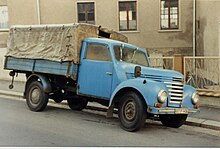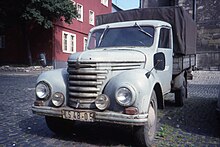Barkas V 901/2
| Framo / Barkas | |
|---|---|
|
V 901/2 pickup truck (restored)
|
|
| V 901/2 | |
| Manufacturer: | VEB Barkas-Werke Karl-Marx-Stadt |
| Production period: | 1954-1961 |
| Previous model: | Framo V 901 |
| Successor: | Barkas B 1000 |
| Technical specifications | |
| Designs: | Flatbed , box vans , station wagons, minibuses , ambulances |
| Engines: | 3-cyl two-stroke - Otto engine , 0.9 l |
| Power: | 18-21 kW |
| Payload: | 0.5-0.8 t |
| Perm. Total weight: | 1.9 t |
The Barkas V901 / 2 is a small van that was manufactured between 1954 and 1961 by VEB Barkas-Werke Karl-Marx-Stadt (until 1956: Framo in Hainichen ). Because of its origin it is often called Framo V 901/2 in general . In 1956 it was called the Framo V 901/2-Z . The three-quarter- tonner was the smallest truck in the GDR vehicle construction at the time and was located below the granite phenomenon .
history
While maintaining the technology, the Framo V 901 was further developed in 1954 to the externally redesigned type V 901/2. The cab was significantly enlarged and its design adapted to the zeitgeist of the early 1950s. Like its predecessor, the pickup truck was available with various bodies, with the pickup truck being the most common version. In addition, there were now also special bodies for the police, post office and trade organizations. The various designs were partly created as superstructures in the bodyworks in Halle and Döbeln . The body shop in Baalberge produced a box body . The maximum speed was 75–82 km / h, depending on the gear ratio and structure.
The naming of the individual further development stages was not consistent with the Framo V 901/2. A Type V 901/3 followed in 1956 with a wheelbase extended to 3.3 m. However, this was only produced for a short time. Instead, the production of a type V 901/2-Z was continued, which with 2.8 m or optionally 3.1 m also had a longer wheelbase than the first models. A number of further improvements had been implemented: The engine output rose from 18 to 21 kW (24 or 28 PS) and the brakes were reinforced. The station wagon, minibus and ambulance bodies were equipped with heating. The Z , which stands for intermediate type , indicates that it was not originally planned to produce the vehicle until 1961. In 1957 the factory was renamed VEB Barkas-Werke , only to be renamed again a year later as VEB Barkas-Werke Karl-Marx-Stadt . Accordingly, the name of the vehicle changed to Barkas V 901 , and the name V 901/2 soon became established again. In 1958 the tank volume was increased from 32 to 42 liters.
The V 901/2 was exported to Holland , Belgium , Finland and Hungary . For political reasons, even in the 1960s the annual numbers did not reach the pre-war level of up to 5750 vehicles. This meant that neither domestic demand nor export opportunities could even come close to being covered.
Because of the acute shortage of vans in the GDR, numerous V 901/2 were still being used in everyday life at the end of the 1980s. Thanks to the frame construction and ongoing spare parts production, worn specimens could be rebuilt relatively easily. This often resulted in the installation of replacement frames that either have abnormal or no frame numbers, which today sometimes causes irritation. The vans quickly disappeared from the streets after the fall of the Wall . The V 901/2 has long since achieved classic car status. A total of 25,604 pieces of type 901/2 were manufactured.
Technical specifications
| Barkas V 901/2 (model 1960) | |
|---|---|
| Engine: | Otto engine, two-stroke (reverse scavenging), three cylinders in line |
| Displacement: | 901 cc |
| Bore × stroke: | 70 mm × 78 mm |
| Power: | 20.6 kW (28 hp) at 3600 rpm |
| Max. Torque: | 73.5 Nm at 2500 rpm |
| Compression: | 6.25 |
| Cooling: | water |
| Transmission: | 4 + 1 (unsynchronized), with steering column shift |
| Lubrication: | Mixture lubrication in a ratio of 1:25 |
| Alternator: | 6 V |
| Landing gear: | Wishbones + transverse spring front, rigid axle rear, drum brakes front / rear |
| Empty weight: (flatbed / box + station wagon) | 1000/1210 kg |
| Dimensions L × W × H: (flatbed / box + combi): | 4360/4350 × 1600/1650 × 1650/1910 mm |
| Top speed: | 75-82 km / h |
literature
- The Framo commercial vehicle of the type V901 / 2 Z. In: Motor vehicle technology 1/1956, pp. 19–22
- Jürgen Lisse: Vehicle Lexicon Framo / Barkas. Bildverlag Böttger GbR, Witzschdorf 2008, ISBN 978-3-937496-23-8
- Udo Stünkel: Type of GDR vehicles. Passenger and delivery vehicles. Verlag Peter Kurz 2000, ISBN 3-9806977-9-7
- Peter Kirchberg: Plastic, sheet metal and planned economy. Nicolaische Verlagsbuchhandlung, 2000, ISBN 3-87584-027-5
Web links
- framo.de - detailed company history, type tables, restoration, pictures, Framo forum
Individual evidence
- ^ Motor vehicles at the Leipzig spring fair in 1956. In: Motor vehicle technology 3/1956, p. 86.
- ^ The nationally owned vehicle construction at the Leipzig spring fair in 1958. In: Motor vehicle technology 3/1958, pp. 95–98.
- ↑ http://www.framo.de/



